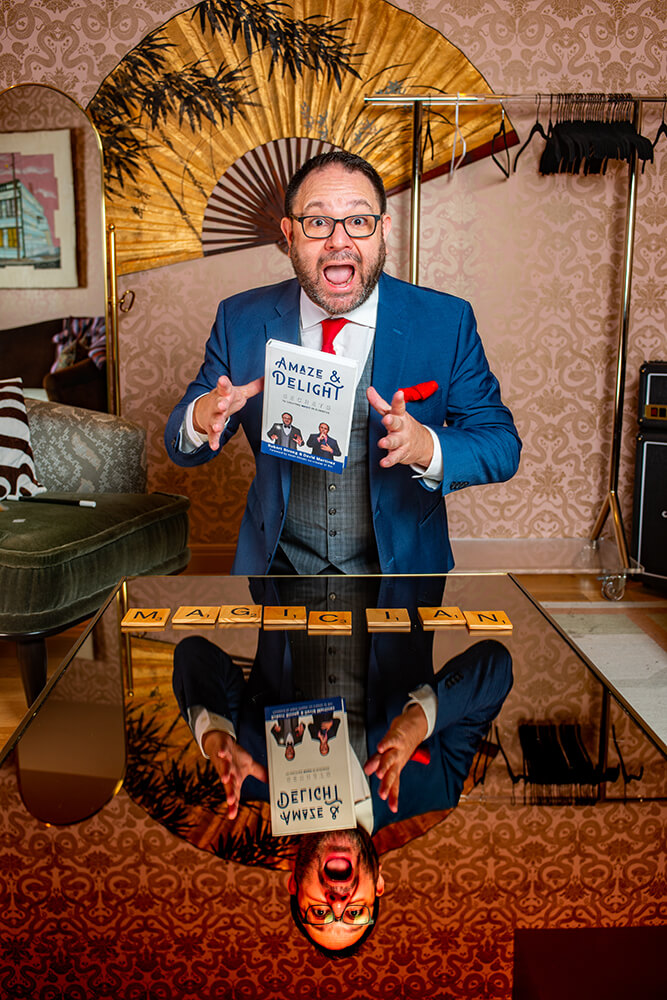Words by Johanna Harlow
Interested in a little magic? Robert Strong poses this question to a table of strangers at a restaurant. They assess this newcomer a moment before slowly giving their consent. But as Robert holds out a wad of cash, turning Washingtons into Benjamins, they uncross their arms and lean in. By the time he’s started making cards disappear, the wariness has melted into warmth. He leaves the table having gained a few new friends.
“Magic changes people,” Robert observes as he moves away. “They behave like nine-year-olds who’ve just discovered that there really is magic in the world. I love that change: from being skeptical, ‘Why would I want to watch this?’ to, ‘You gotta see what I saw!’”
Robert has lit up audiences in all 50 states and 45 countries. “Kids’ birthday parties, schools, fairs, festivals, colleges, universities, comedy clubs, cruise ships,” he ticks off on his fingers. What’s more, he’s appeared on Penn & Teller: Fool Us, given a TED Talk, served as an artist in residence for the Smithsonian and carved out a niche for himself performing at Fortune 500 companies.

He’s even performed for two presidents. “Very different,” Robert chuckles of his two visits to the White House. “For George Bush Sr., they took apart all my stuff, put it through the X-ray machine, searched under my car—and for Bill Clinton, they’re like, ‘Oh, you check the missiles at the next gate. Just kidding. Come on in!’”
Robert’s first encounter with magic occurred at the age of 12 when a street performer’s act held him spellbound. “Time stood still. It was like, ‘This is the thing,’” Robert recalls. “A switch flipped in my brain. I said, ‘That’s what I want to do.’” On a mission, Robert learned his first few tricks from a podiatrist who shared an office building with his father, then improved his sleight of hand at Tannen’s Magic Camp. “Every waking hour was reading and studying and training.”
Then came his first gig. “It was a kid’s birthday party, walking distance from my house,” Robert reminisces. “It was a 10-minute show and I got paid $10. I was like, ‘A dollar a minute? This is it!’ I took that $10, bought another magic trick and kept going.” These days, youthful audiences aren’t his focus. “You don’t have to win them over,” he shrugs. There’s something more gratifying about converting adults from cynics into believers.

As Robert developed as a performer, he took up improv comedy. He recalls a particularly memorable evening sharing the stage with the late Robin Williams. Of everyone performing, “I was by far the youngest and least experienced,” he recalls. So he asked the other entertainers if they’d like to warm up first by spitballing about current events and pop culture. All but one said no. “Robin Williams, who was in person very soft-spoken and gentle, very thoughtful, he said, ‘I’d like to warm up.’” Everyone changed their tune and joined in. “He took care of everybody! I learned so much from him.”
As Robert looks back on his journey, he reflects, “I used to love the trick. Then I loved the laughter. Then I fell in love with the fact that, with magic, you get connection.” He credits his success to taking an audience-first approach and avoiding one-size-fits-all routines. “The thing that differentiates me from other magicians is not the tricks, not the pickpocketing, not the juggling. It’s that I really personalize the experience,” he concludes. “That’s become my calling card.”
For the past two decades, he’s brought that talent to corporate gigs. It starts with doing a 20-minute culture interview in advance of every performance. “I ask things like: What’s unique about your company? What are your goals? Who’s your competition?… What’s funny about your company? What is the gossip at the water cooler that everyone likes to complain about?” If the head of the company is known to pop up unexpectedly, Robert has the CEO appear during his show. If everyone drinks LaCroix, or the corporate softball team gets a tad too competitive, he’ll weave in a joke about it. “The illusions that I create are never the same,” he says. “I want them to ask, ‘Does he actually work here?’”

It’s also Robert’s job as CMO (“Chief Magic Officer,” he jokes) to inspire business teams. “If you want to create a culture or an experience for a customer that feels like magic, you do a lot of work that’s invisible,” he explains. “I give examples of magic tricks that I perform that take a lot of prep work that you don’t see. When it works, it feels like magic. It’s instant. You don’t see the thousands of hours that went into getting it right.”
He shares this lesson and others in his book Amaze & Delight: Secrets to Creating Magic in Business (“And it should be ‘and Life, Too,’” Robert comments). He co-wrote it with David Martinez, a former marketing professional who quit his job at Apple to become a full-time magician.
“Magicians will see things from other people’s points of view, put themselves in their perspective,” Robert says of his empathetic approach to magic. “The high you get, the hit that you get from entertaining other people, bringing joy to other people, will be more than what they receive.”
To watch Robert work his magic at The Guild in Menlo Park or other venues around the Bay Area, check out his website: strongentertainment.com


